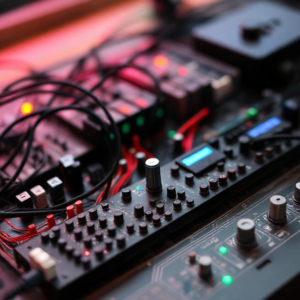What is Audio Electronics?
Audio electronics refers to the electronic devices and systems that help us produce, process, and hear sound. They play an essential role in things like speakers, microphones, sound systems, and musical instruments.

In short, audio electronics help turn electrical signals into sound waves, which we can hear with our ears.
Basic Concepts of Sound
Before diving into audio electronics, let’s quickly review what sound is:
- Sound is made up of vibrations in the air, which travel as sound waves.
- When something makes noise (like a musical instrument or someone speaking), it creates vibrations. These vibrations move through the air and reach your ears, allowing you to hear the sound.
In audio electronics, we work with electrical signals (which represent sound) to control, amplify, or change the sound we hear.
Main Components of Audio Electronics
- Microphone: A microphone takes sound from the air (like someone talking or a guitar being played) and converts it into an electrical signal. Essentially, it turns sound into electricity.
- For example, when you speak into a microphone, it picks up the vibrations from your voice and turns them into an electrical signal that can be sent to speakers or a recording device.
- Amplifier: The amplifier is the device that boosts the strength (or power) of the electrical signal. Sound signals from microphones or other sources are often very weak, so we need an amplifier to make them stronger.
- Think of a speaker as a “loudspeaker” that needs a strong signal to make sound loud enough for you to hear. The amplifier takes the weak signal and makes it louder without changing the sound too much.
- An audio amplifier takes the electrical signal and increases its power, so it can drive the speakers and produce a loud sound.
- Speaker: A speaker is the device that takes the amplified electrical signal and converts it back into sound. Inside a speaker, there is a magnet and a cone that moves when the electrical signal flows through, creating vibrations in the air that you hear as sound.
- When you plug an amplifier into a speaker, the speaker turns the strong electrical signal into the vibrations that make sound waves.
The Process of Sound Amplification
Here’s a simple step-by-step of how sound is amplified:
- Capture Sound (Microphone): A microphone captures sound from the environment (like music or a voice) and converts it into a small electrical signal.
- Amplify the Signal (Amplifier): The weak electrical signal is sent to an amplifier. The amplifier increases the power of the signal, making it stronger and able to drive a speaker.
- Produce Sound (Speaker): The amplified signal is sent to a speaker. The speaker turns the electrical signal back into sound by moving air with its vibrating cone, and that’s the sound you hear.
Types of Amplifiers
There are different types of amplifiers, each used for specific situations:
- Class A Amplifiers: High-quality sound but less efficient. Used in professional audio equipment.
- Class D Amplifiers: Very efficient and commonly used in portable speakers and car audio systems.
Other Important Audio Components
- Equalizer (EQ): An equalizer helps change the sound by adjusting the bass (low frequencies), midrange (middle frequencies), and treble (high frequencies). This allows you to shape the sound to make it brighter or deeper.
- Mixing Console: In more complex audio systems (like concerts or studios), a mixing console combines multiple audio signals (like different microphones or instruments) and adjusts their volume, balance, and effects.
Summary
Here’s a recap of how audio electronics work:
- Microphone captures sound and turns it into an electrical signal.
- Amplifier boosts the electrical signal to make it stronger.
- Speaker turns the amplified signal back into sound that you can hear.
This basic process allows us to record, amplify, and listen to audio, whether it’s music, speech, or any other kind of sound.
In real-world applications, audio electronics can be used in everything from home theater systems to concerts, headphones, and even smartphones!











